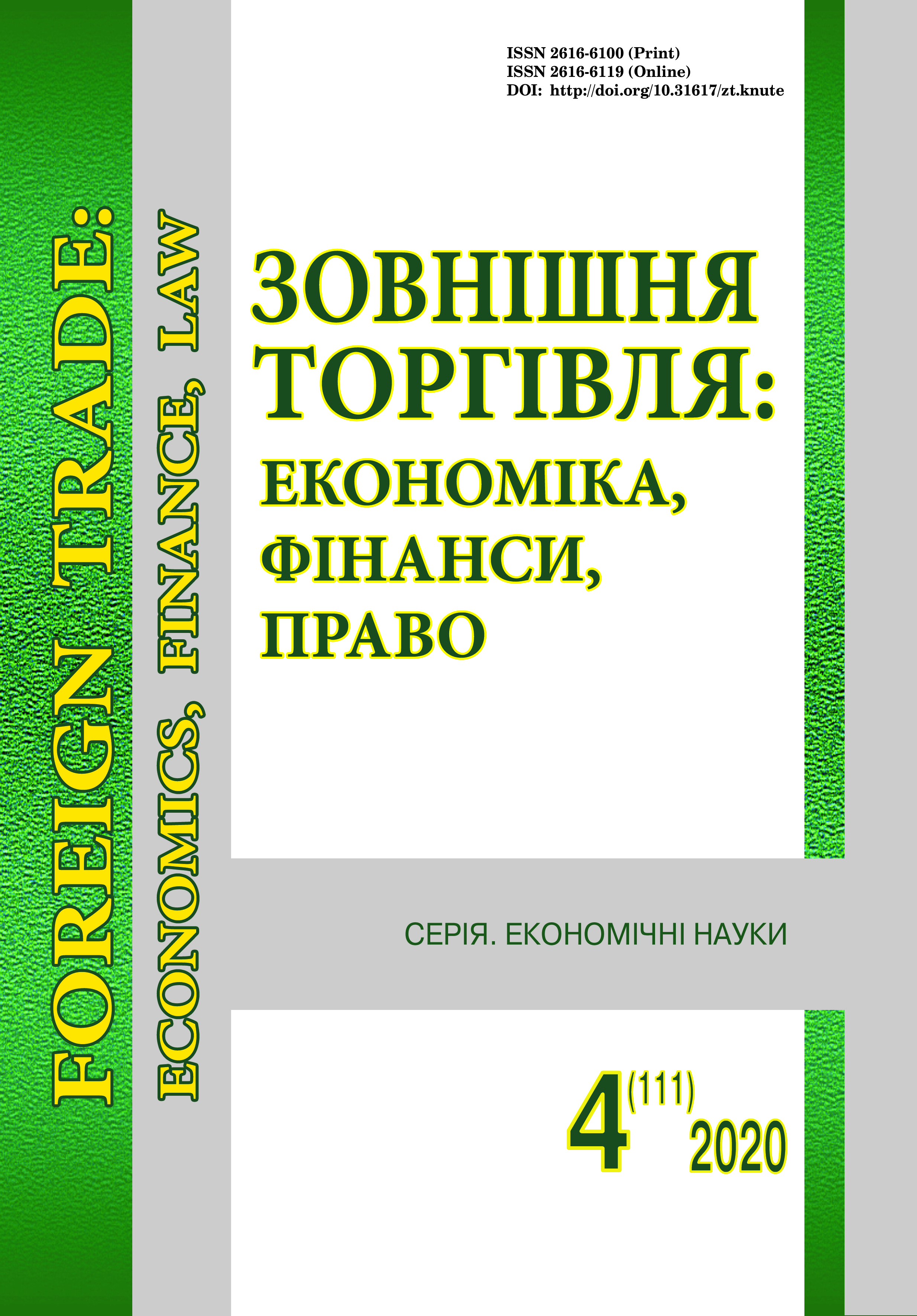Grain exports of Ukraine
DOI:
https://doi.org/10.31617/zt.knute.2020(111)06Keywords:
exports, imports, cereals, agricultural land, arable land.Abstract
Background. Today, the agro-industrial complex plays an important role in the development of the entire economy of the country. At the same time, agriculture, as a component of this complex, is intended, chiefly, to ensure food security in the country. Agricultural production allows to fill the state budget with foreign currency in the context of fast growing demand for foodstuffs. Therefore, it is important to promote a sound export policy. Exports and imports of crops must be balanced.
An analysis of last researches and publications. Today, the works of most agricultural economists are devoted to the study of the common problems of development of the agro-industrial complex. Some scientists analyze and evaluate the export potential of our country in the markets of the European Union. Other scholars identify current trends in changing supply and demand for certain types of agricultural products. There are very few works assessing agricultural exports and imports as a coherent system of agro-industrial policy.
The aim of the article is to identify and analyze the main factors that affect the export of cereals and legumes, as well as to justify the most favorable ways to increase its volume from Ukraine in modern conditions.
Materials and methods. Graphic, tabular, economic, statistical methods and the method of comparison were used during the research.
Results. The analysis shows that the countries of the European Union are currently the most desirable trading partners for domestic agricultural producers. However, EU quotas remain the main obstacle to a significant increase in agricultural exports to Europe. These quotas are particularly low for meat and dairy products. One promising way out of the current situation is to develop agricultural markets in other countries. The current geographical structure of cereal exports from Ukraine indicates a significant export potential in Africa, Asia and Latin America. At the same time, it is advisable to increase the volume of exports of livestock products, in particular, by regulating the export and import of cereals.
Conclusion. Based on the research, it is necessary to optimize the export and import of not only cereals, but also other crops. At the same time, an increase in cereal exports should not be detrimental to the development of the livestock and food industry, which generates a higher level of value added than the crop industry. The geographical structure of grain exports should diversify, first of all, through the development of non-European markets. Countries with the smallest areas of agricultural land and, in particular, arable land per capita, are the most promising for a significant increase in cereal exports.
References
Danylenko, A. S. (2013). Organizacijno-ekonomichni zasady realizacii' eksportnogo potencialu sil's'kogospodars'kyh pidpryjemstv [Organizational and economic principles of realization of export potential of agricultural enterprises]. Ekonomika ta upravlinnja APK – Economy and management of agribusiness APK, 11, 5-10 [in Ukrainian].
Antonyuk, O. P., & Antonyuk, P. O. (2014). Analiz struktury eksportu ahroprodovol'choyi produktsiyi [Analysis of the structure of export agri products]. Ekonomika kharchovoyi promyslovosti – The economy of the food industry, 3, 27-32 [in Ukrainian].
Strochenko, N. I. (2014). Ekonomichni aspekty zrostannya eksportu produktsiyi APK Ukrayiny u konteksti zaprovadzhennya standartiv iz vuhletsevoyi sertyfikatsiyi [Economics of growth of exports of agricultural products Ukraine in the context of the implementation of the carbon standards certification]. Ekonomika – Economics, 7, 75-81 [in Ukrainian].
Kozak, O. A., & Gry`shhenko, O. Yu. (2016). Rozvytok zernovoi' galuzi Ukrai'ny na suchasnomu etapi. [Development of the grain industry of Ukraine at the present stage]. Ekonomika APK – Economics of agro-industrial complex, 1, 39 [in Ukrainian].
Koval`ova, O. M. (2015). Ocinka potencialu rozvytku zernovogo pidkompleksu ekonomiky Ukrai'ny [Estimation of the potential of the development of the grain subcomplex of the Ukrainian economy]. Global'ni ta nacional'ni problemy ekonomiky – Global and national economic problems, (Iss. 7) [in Ukrainian].
Shpy`chak, O. M. (2014). Potencial rynku zerna v Ukrai'ni: problemy ta perspektyvy [Potential of the grain market in Ukraine: problems and perspectives]. Ekonomika APK – Economics of agro-industrial complex, 7 [in Ukrainian].
Mesel`-Veselyak, V. Ya. (2018). Vyrobnyctvo zernovyh kul'tur v Ukrai'ni: potencijni mozhlyvosti [Production of grain crops in Ukraine: potential opportunities]. Ekonomika APK – Economics of agro-industrial complex, 5 [in Ukrainian].
Ministerstvo rozvytku ekonomiky, torhivli ta silʹsʹkoho hospodarstva Ukrayiny [Ministry of Economic Development, Trade and Sylvian Statehood of Ukraine]. (n.d.). me.gov.ua. Retrieved from https://me.gov.ua/Documents/List?lang=uk-UA&id=c6f1c10b-791e-4067-8580-09e2f2739f8e&tag=ZonaVilnoiTorgivliMizhUkrainoiuTas [in Ukrainian].
Derzhavna sluzhba statystyky Ukrayiny [State Statistics Service of Ukraine]. (n.d.). ukrstat.gov.ua. Retrieved from http://www.ukrstat.gov.ua/.[in Ukrainian].
FAOSTAT. Vybrani pokaznyky [FAOSTAT. Selected Indicators]. (n.d.). fao.org. Retrieved from http://www.fao.org/faostat/ru/#country [in Ukrainian].
Ukrai'ns'kyj klub agrarnogo biznesu. Zernovi kul'tury [Ukrainian Agribusiness Club, Zernovi kulʹtury [Cereals]. (n.d.). ucab.ua. Retrieved from http://ucab.ua/ua/doing_agribusiness/agrarni_rinki/zernovi [in Ukrainian].
Additional Files
Published
How to Cite
Issue
Section
License
Copyright (c) 2022 Foreign trade: Economics, Finance, Law

This work is licensed under a Creative Commons Attribution 4.0 International License.
This work is licensed under a Creative Commons Attribution 4.0 International (CC BY 4.0)







